MARLIN DIY
PART 2
Last month we looked at early-season preparation for marlin. For this instalment, we’ll cover setting up your boat for trolling and lure selection.
Words & Images by Ben Brown
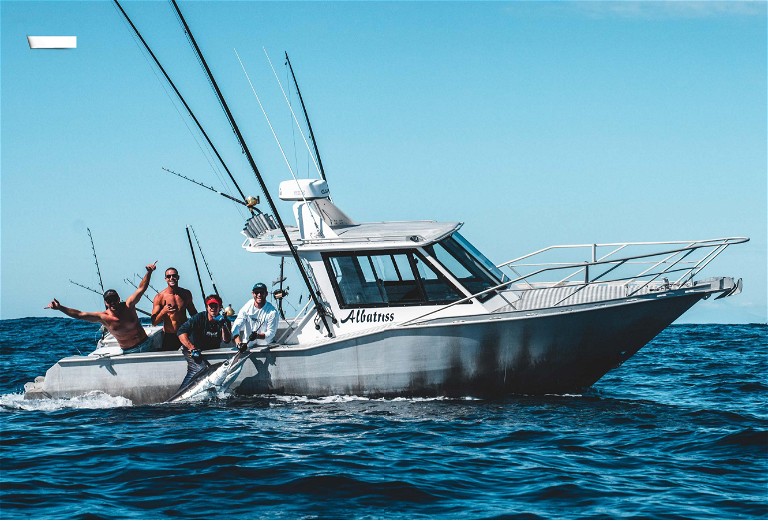
The well-set-up, Kawhia-based trailerboat Albatross chalks up another success.
Boat setup
Now that your gear is serviced and ready, let’s have a look at your outrigger setup. You may already have outriggers and are comfortable with your system, however I’ll share with you how I do it.
To give you a bit of background, I first started gamefishing out of my own boat about 15 years ago. We used to get plenty of bites on our short and long ‘rigger lures and even used to catch the odd marlin here and there. Information about boat setup and fishing techniques was hard to come by and I was generally making it up as I went along. Then in 2014 I met renowned NZ lure maker Graeme ‘Bonze’ Fleet, and everything changed. Bonze introduced me to a new way of setting up my boat, along with the new light gauge system he was developing, and since then I have caught over 130 marlin from my boat.
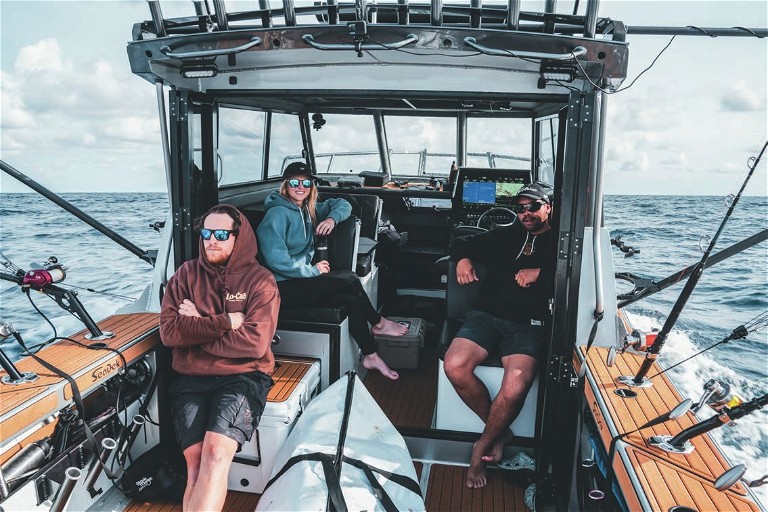
While the crew might not be busy at this stage, you can’t say that of the gunwales that are loaded with teaser systems and the game rods.
I think the single biggest change that Bonze suggested I make to my outriggers, which resulted in me catching more fish, was to run my ‘corner’ lures out of my outriggers. Traditionally, a trailer boat game fisherman in NZ will run either four or five lures with the short and long corners – run off the rod tips – as the closest lures to the boat. The short corner is generally run about three wake waves back from the transom and the long corner on the fourth wave back. Then they’ll run a short ‘rigger lure out of the outrigger a further wave or two back (fifth or sixth wave) on the same side as the short corner (usually port), and a long ‘rigger out of the outrigger on the opposite side on the sixth or eighth wave back. Not all trailer boats put up a very good wake, so you’ll need to experiment on your own boat to find where the best position is for each lure. Many skippers also opt to run a ‘shotgun’ lure in a long position straight down the middle of their spread, either run off the rod tip or out of a centre ‘rigger pole.
Up until I made the change to run my corners out of my outriggers, I had never had a bite on my short corner lure. Now I would say it is the most productive position on my boat. I am unsure of the reason for this – perhaps the lures run in cleaner water when they are run out of the ‘riggers, or maybe less leader is dragging in front of them. Whatever the reason is, what I do know is that it works! To run my corner lures from my outriggers, I added a second halyard, which runs through an eyelet one-third of the length of the outrigger from the tip.
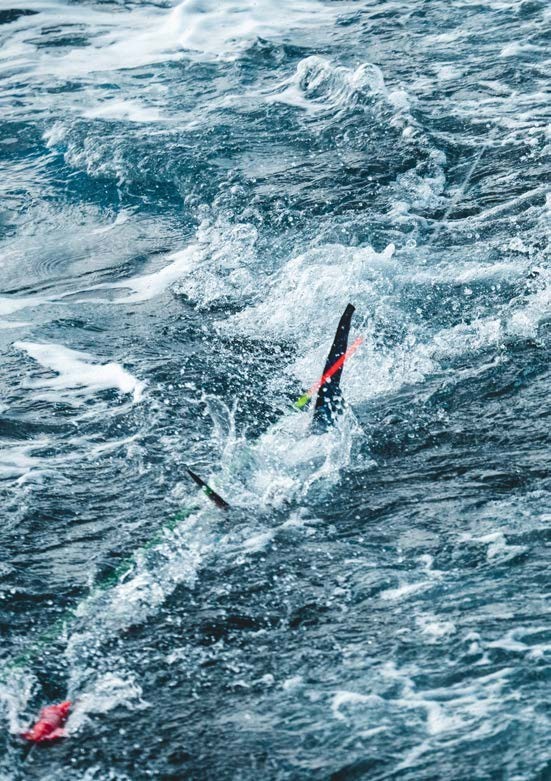
Ben will run up to three dredges/teasers when conditions allow to attract marlin.

A well-set-up boat and lure spread has seen the Heavy Metal crew account for over 130 billfish since radically changing key elements of their trolling operation.
“ …I RAN MY LURES SLIGHTLY FURTHER BACK, EFFECTIVELY PUTTING MY TEASERS WHERE MY CORNER LURES HAD PREVIOUSLY BEEN. ”

Jimi Ham with a stripey before release.
“ …THE MOST IMPORTANT INVESTMENT INTO YOUR GAMEFISHING SYSTEM WOULD BE A GOOD SET OF OUTRIGGERS. ”
I have also incorporated a teaser system into my spread which has very clearly resulted in raising more marlin. On my port side I’m running a strip dredge off a dredge boom that I deploy and retrieve with an electric reel. On both my port and starboard sides I am also running teaser chains. My dredge runs under the surface just in front of my short corner lure and the teaser chains run in front of my short and long corner lures. Once I incorporated the teasers into my system, I found it worked better if I ran my lures slightly further back, effectively putting my teasers where my corner lures had previously been. Over the last couple of seasons, I have added a third halyard to my outriggers and now run my teaser chains from my riggers as well – this has resulted in a lot more fish popping up on my surface teasers. There’s nothing more exciting than a lit-up marlin popping up right behind the transom of the boat!
I know this all sounds complicated but once you get your head around it, you’ll find that it all makes sense.
I think if I could recommend the most important investment into your gamefishing system it would be a good set of outriggers. A good pair of correctly set up outriggers will help you catch fish when the opportunity presents itself.
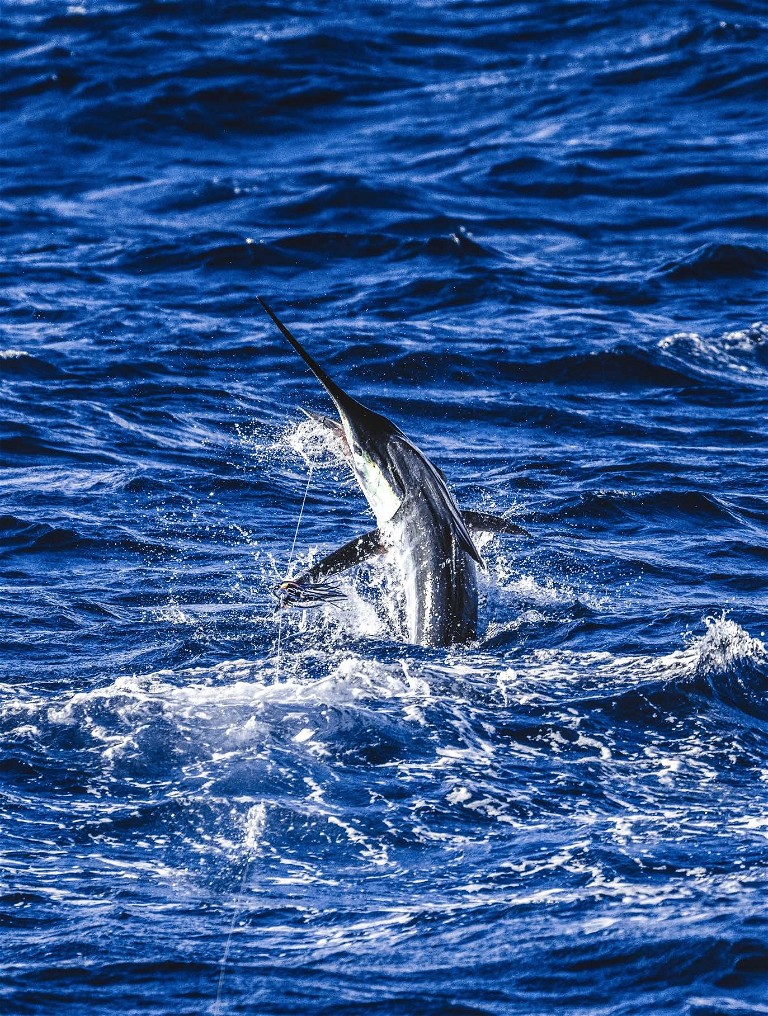
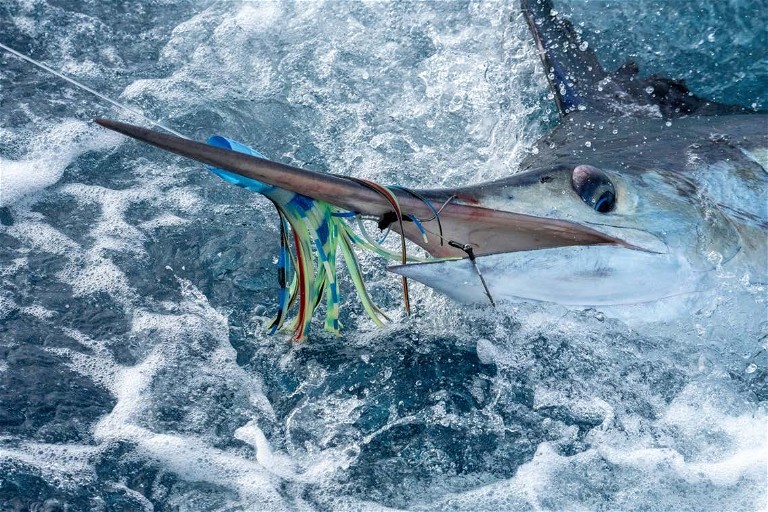
Finding the right lure for the right spot in the pattern will result in more hookups.
BEN’S FAVOURITE LURE SPREAD
As I have already said – everyone has their favourite lure and colour combinations, but if you are interested in mine they are as follows:
• Short Corner – Bonze Trojan in Spirit colour
• Long Corner – Bonze Undertaker in Saury colour
• Short ‘Rigger – Bonze D Shackle in custom Heavy Metal colour
• Long Rigger – Bonze Weapon in Chill colour with a Hawaiian Malolo Bird Teaser
• Shotgun – Bonze Heat in Boss colour
It can be quite daunting when you start to price what you need to create your gamefishing system but bear in mind you don’t need to buy lots of gear, just the right gear. You also don’t have to buy everything all at once, but rather start buying the pieces as you go to build your system. If you need to, start with a set of good outriggers and three rod-and-reel combos, then add the rest as your budget permits.
Lure selection
Marlin are like fishers, they come in all shapes and sizes. What I have found is that most lures will work if you run them far enough out and you will most likely develop your own favourites based on what works behind your boat. As a general rule of thumb, lures with a cup face will hold a straighter line and create fantastic bubble trails whereas angle-faced lures will run more aggressively and generally are better on calmer days. Bullet head lures are best suited further back in your spread and are often run in the long rigger or shotgun position.
The most important thing is that your lures are running correctly and that will take some fine tuning depending on your boat. You want your lures to create a lot of attention on the surface and plenty of splash without the lure jumping and tumbling out of the water. Nothing warms my heart more than seeing my lures creating a nice big splash on the surface before momentarily holding under the water, creating a very visible bubble trail… marlin love that sort of thing!
How your lures run will also depend on sea conditions and your trolling speed. I prefer to troll between 7-8 knots and have found that boats have a sweet spot that they work best at – you will generally base this on RPM rather than boat speed as things like sea conditions and currents will make your speed vary while your lures will still be running great. I’ve caught marlin when my electronics have been telling me I’m going five knots and I’ve caught marlin when my electronics have said I’m going 10 knots – as long as my lures are running perfectly I’m happy.
Choosing your lure colour is somewhat of a dark art – there is no question some colours get more bites, and most marlin anglers will have their favourite colours for different positions. Logic would suggest that darker colours will have a better profile in the whitewash closer to the boat, and colours that resemble the local baitfish population should be more attractive to hungry marlin in the area, but at the end of the day, I just go for a variety of colours that have worked for me in the past.
Keep your eyes peeled for the final article on finding fish and what to do once you have hooked the big one in the next issue of NZ Fishing News!